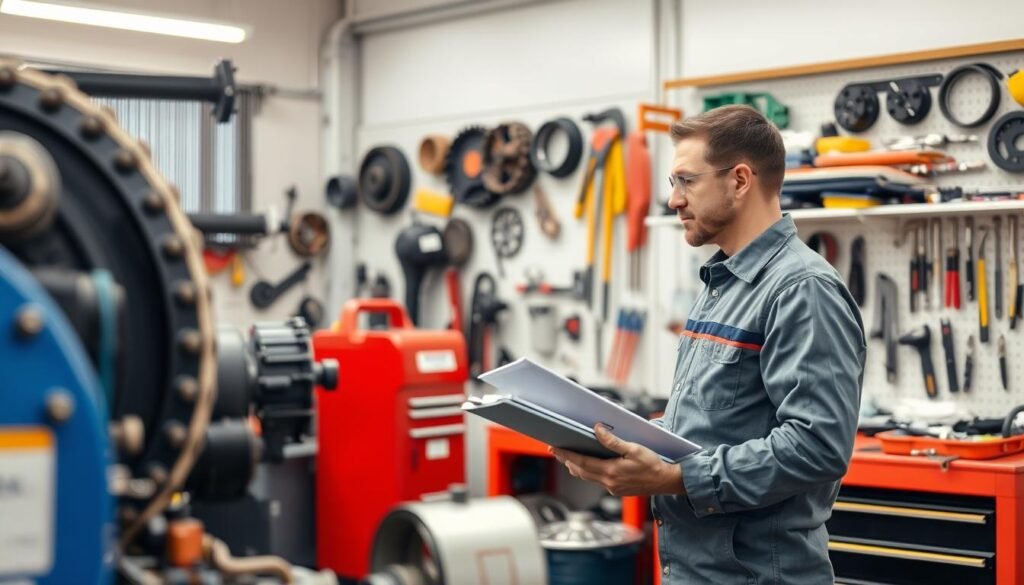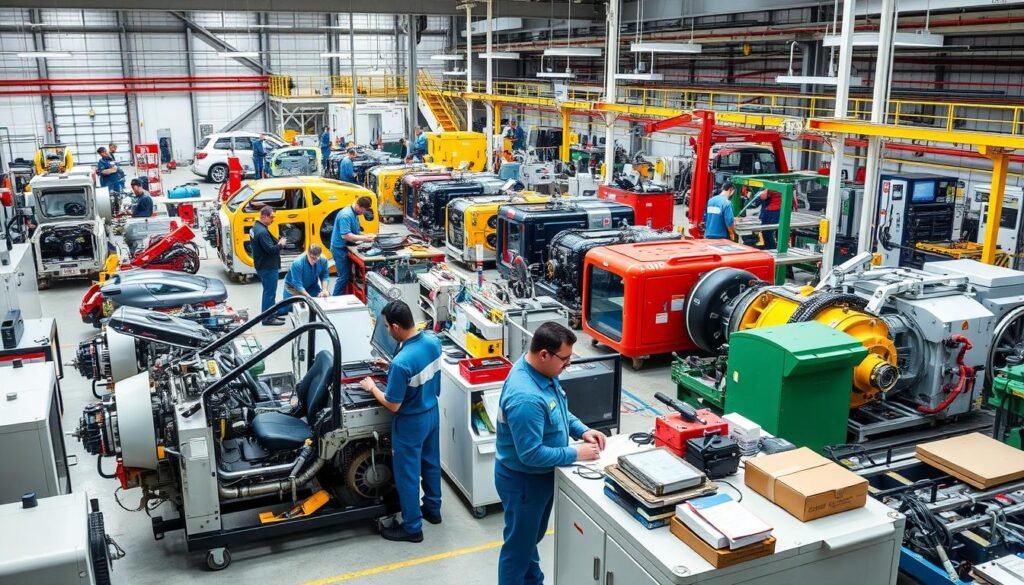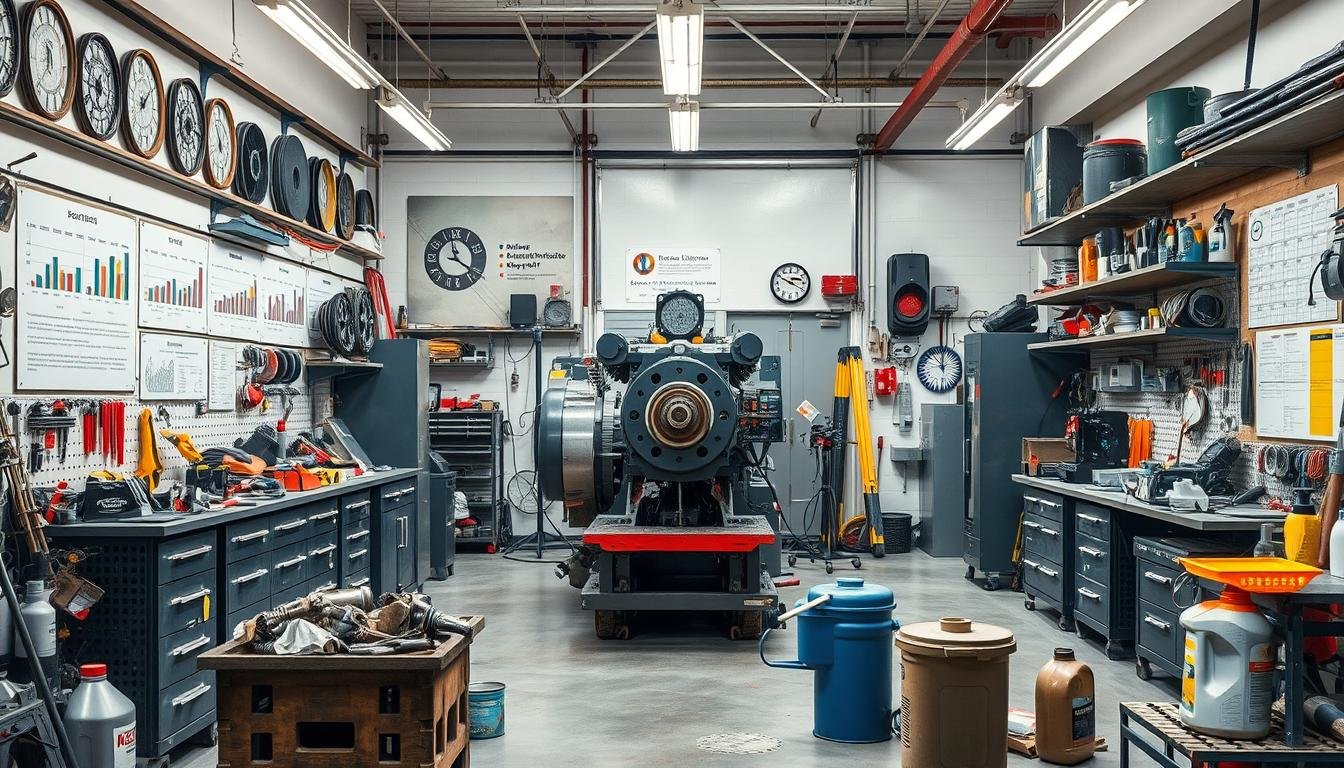Did you know that companies can lose up to 20% of their productivity due to unplanned downtime? Preventive maintenance (PM) is a proactive approach that aims to decrease such disruptions by ensuring equipment upkeep through scheduled inspections and repairs. This maintenance strategy is not just a luxury; it’s a vital component to keep operations running efficiently, especially as machinery complexity increases across various industries.
By investing in preventive maintenance, organizations can significantly enhance their operational longevity and profitability. Implementing a robust PM program helps in identifying potential failures before they occur, ultimately leading to smoother operations and reduced repair costs. To dive deeper into the importance of preventive maintenance, you may want to read more about it here.
As we explore the nuances of preventive maintenance in the following sections, you will uncover the comprehensive benefits it offers, the essential components of an effective program, and how technology can elevate your maintenance efforts.
Key Takeaways
- Preventive maintenance reduces downtime and enhances productivity.
- Strategic maintenance can prolong equipment lifespan.
- Implementing PM leads to substantial cost savings.
- Routine inspections are crucial for identifying potential issues.
- Technology plays a vital role in modern maintenance strategies.
What is Preventive Maintenance?
Preventive maintenance is a critical strategy, employed across diverse sectors, aimed at extending equipment lifespan and enhancing reliability. This proactive methodology involves routine inspections and scheduled maintenance, designed to mitigate the likelihood of unforeseen equipment failures. Through meticulous maintenance scheduling, entities can orchestrate a systematic sequence of maintenance activities, thereby ensuring the uninterrupted operation of their systems.
Definition and Overview
At its core, preventive maintenance encompasses a series of activities aimed at averting potential malfunctions. It includes comprehensive assessments, timely repairs, and continuous condition monitoring. The adoption of such a framework significantly enhances the importance of preventive maintenance, cultivating a culture of accountability and vigilance amongst maintenance personnel.
Importance in Various Industries
Diverse sectors, including manufacturing, healthcare, and facilities management, derive substantial benefits from preventive maintenance practices. For instance:
- Manufacturing: Reduced downtime translates into increased productivity and smoother operations.
- Healthcare: The reliability of equipment is paramount for patient safety and optimal service delivery.
- Facilities Management: Consistent upkeep fosters a safer and more efficient environment for occupants.
By acknowledging the importance of preventive maintenance, corporations can enhance not only their equipment’s longevity but also their overall operational efficiency. This strategy ultimately results in cost savings, ensuring that businesses maintain their competitive edge.
The Benefits of Preventive Maintenance
In the domain of facility management, the adoption of preventive maintenance unveils a plethora of advantages, profoundly influencing an organization’s operational efficacy. By emphasizing regular maintenance and prompt repairs, entities can reap a series of benefits that transcend immediate solutions.
Enhanced Equipment Lifespan
Preventive maintenance’s primary advantage lies in its ability to extend equipment lifespan. Through systematic inspections and timely servicing, organizations can mitigate the wear and tear on machinery. This proactive methodology enables the identification of potential issues before they become major problems, facilitating minor repairs over costly replacements.
Reduced Downtime
Preventive maintenance is instrumental in curtailing downtime. By addressing issues before they result in equipment failure, organizations can sustain uninterrupted operations. With fewer unexpected breakdowns, productivity levels are maintained, allowing teams to concentrate on their primary responsibilities without interruptions.
Cost Savings and Efficiency
Adopting a preventive maintenance strategy yields substantial cost savings. By averting major breakdowns and emergency repairs, operational costs are significantly reduced. Additionally, organizations experience enhanced efficiency in their workflows, as well-maintained equipment operates at peak performance, ensuring optimal resource utilization.
Key Components of a Preventive Maintenance Program
A successful preventive maintenance program integrates critical elements, ensuring optimal performance and longevity of equipment. These components enhance routine maintenance efforts, thereby minimizing unexpected breakdowns.
Routine Inspections
Routine inspections are pivotal in a preventive maintenance program. Regular assessments of equipment facilitate the early detection of potential issues. This proactive approach prevents major problems, saving costs and ensuring a safer working environment.
Scheduled Maintenance Tasks
Scheduled maintenance tasks, based on manufacturer recommendations or historical data, are crucial for systematic upkeep. These tasks should be documented in a maintenance checklist to ensure every critical component receives timely attention. Consistent scheduling minimizes disruptions and enhances operational efficiency.
Monitoring and Reporting Systems
Implementing monitoring and reporting systems significantly enhances the effectiveness of preventive maintenance programs. These systems facilitate continuous data collection, informing asset management decisions. By analyzing trends and performance metrics, organizations can adapt their maintenance strategies effectively. For additional insight into establishing a strong maintenance foundation, visit this resource.
How Preventive Maintenance Works
The intricacies of preventive maintenance are paramount for maximizing equipment efficacy. This methodology hinges on a structured framework, where a maintenance cycle is meticulously crafted to orchestrate, perform, and assess tasks incessantly.
The Maintenance Cycle Explained
The maintenance cycle is pivotal in guaranteeing equipment dependability. It encompasses several phases:
- Planning: Establish the maintenance tasks required, drawing from manufacturer recommendations and past performance records.
- Execution: Perform scheduled maintenance activities to mitigate wear and tear.
- Evaluation: Assess the efficacy of maintenance endeavors to pinpoint areas for refinement.
Adherence to this cycle enables organizations to anticipate potential failures and refine their maintenance tactics to reduce risks. Consequently, equipment functions more efficiently, thereby boosting overall productivity.
Role of Technology in Maintenance
Technological advancements have revolutionized preventive maintenance practices. Innovations like IoT devices and AI analytics offer real-time insights, empowering teams to anticipate maintenance requirements with precision. These advancements enable prompt interventions, ensuring equipment operates at its optimal level.
Types of Preventive Maintenance
Grasping the nuances of preventive maintenance is paramount for any entity aiming to elevate operational efficacy. Each maintenance category fulfills unique objectives, ensuring apparatus functions at peak performance and mitigating the probability of unforeseen malfunctions. Below, we delineate the prevalent maintenance modalities utilized across various sectors.
Time-Based Maintenance
Time-based maintenance entails the execution of maintenance tasks at predetermined intervals. This paradigm guarantees that machinery receives consistent upkeep, thereby extending its operational life. Adherence to schedules is crucial, with maintenance tasks scheduled according to manufacturer guidelines or internal protocols.
Usage-Based Maintenance
Usage-based maintenance is activated by the actual utilization of equipment. By tracking performance metrics, entities can identify when maintenance is imperative, thereby averting over-servicing. This method is particularly efficacious in high-usage environments, facilitating proactive interventions just before equipment failure.
Predictive Maintenance Techniques
Predictive maintenance transcends traditional preventive measures by integrating data analytics and machine learning. This advanced approach anticipates equipment failure, allowing for the precise calibration of maintenance schedules. By adopting predictive maintenance, organizations can optimize resource allocation, reduce downtime, and elevate overall productivity.
Bridging the Gap: Preventive vs. Reactive Maintenance

The distinction between preventive and reactive maintenance is paramount for entities seeking operational optimization. Preventive maintenance entails the proactive identification and resolution of potential issues, thereby averting their escalation. Conversely, reactive maintenance addresses problems post-manifestation. This forward-thinking strategy minimizes unforeseen downtimes and subsequently curtails operational expenditures, rendering preventive maintenance a favored option for numerous enterprises.
Understanding the Differences
The disparity between preventive and reactive maintenance profoundly influences an organization’s operational efficacy. Preventive maintenance encompasses routine inspections, scheduled undertakings, and expedient rectifications, fostering a systematic approach to equipment management. In contrast, reactive maintenance precipitates hasty repairs, resulting in prolonged downtimes and elevated costs. Entities must meticulously scrutinize these maintenance dichotomies to harmonize their methodologies with enduring objectives.
Advantages of Preventive Over Reactive
Adopting preventive maintenance strategies confers manifold advantages:
- Improved Equipment Performance: Regular maintenance guarantees apparatus functionality, diminishing the probability of malfunctions.
- Cost Efficiency: Early issue resolution typically incurs lower repair expenditures compared to the costs associated with reactive interventions.
- Consistent Operations: A meticulously maintained system facilitates uninterrupted production, averting unforeseen interruptions.
Opting for preventive maintenance can markedly elevate an organization’s operational efficiency. For those keen on refining their maintenance tactics, acquiring knowledge on structured methodologies can provide invaluable perspectives.
Creating a Preventive Maintenance Plan
The establishment of a meticulously crafted preventive maintenance plan is indispensable for maintaining operational fluidity and the enduring functionality of equipment. This endeavor necessitates a series of pivotal steps, each contributing to a comprehensive maintenance strategy. The inclusion of team members in these phases significantly augments the efficacy of the plan.
Steps for Developing Your Plan
Initiate by pinpointing pivotal equipment necessitating consistent maintenance. This foundational step underpins your preventive maintenance plan. Subsequently, devise a regimen that integrates:
- Routine inspections to monitor equipment conditions
- Scheduled maintenance tasks to address potential issues before they escalate
- Clear documentation of maintenance activities and outcomes
Elaborating on these methodologies empowers teams to adhere to a structured methodology, ensuring accountability and the tracking of tasks executed over time. For entities aiming to refine their business strategies, consider consulting a business registration guide to fortify operational infrastructure.
Involving Your Team
The successful execution of a preventive maintenance plan hinges on the active engagement of your team. Engaging your personnel in the planning phase acquaints them with their roles and responsibilities. This sense of ownership catalyzes more diligent adherence to the maintenance strategy. Encourage feedback and proposals from your team, cultivating a collaborative milieu that prioritizes equipment maintenance.
Regular Review and Adjustments
As maintenance requirements may evolve, regular assessments are imperative. Evaluate the efficacy of your preventive maintenance plan by scrutinizing maintenance data and feedback from team members. Modify schedules and protocols as required to accommodate operational shifts or the advent of new technologies. An agile methodology ensures your plan remains aligned with organizational objectives and fortifies equipment dependability.
Tools for Effective Preventive Maintenance
The implementation of an effective preventive maintenance strategy necessitates the utilization of appropriate tools. Maintenance management software is pivotal in enhancing the scheduling of tasks and inspections, thereby ensuring a systematic approach. This automation significantly reduces the likelihood of overlooked maintenance activities. The employment of thorough checklists and structured schedules serves as a practical preventive maintenance tool, delineating clear steps and timelines for maintenance endeavors.
Maintenance Management Software
Maintenance management software plays a critical role in overseeing all facets of preventive maintenance. It streamlines processes, including the tracking of maintenance tasks, management of inventory, and generation of reports. Users can efficiently plan, prioritize, and document activities, thereby enhancing accountability and minimizing downtime. By automating recurring tasks, organizations can concentrate on ensuring that their equipment operates at peak performance.
Checklists and Schedules
Incorporating checklists and detailed schedules into maintenance routines fosters consistency and thoroughness. A well-organized checklist acts as a reminder of necessary tasks while aiding teams in verifying completion. Establishing schedules ensures that routine inspections and maintenance activities occur promptly, enabling organizations to proactively address potential issues before they escalate.
IoT and Smart Technology
The integration of IoT and smart technology revolutionizes maintenance practices. These advanced technologies enable remote monitoring of equipment, providing real-time insights into performance and condition. Organizations can promptly identify anomalies, facilitating quick responses to address potential failures. The utilization of smart technology not only enhances maintenance strategies but also contributes to optimizing resource allocation and reducing overall maintenance costs.
Industries That Benefit from Preventive Maintenance

Preventive maintenance is pivotal across diverse sectors, significantly boosting operational efficiency and curtailing downtime. Notably, several critical industries have adopted these methodologies.
Manufacturing
In the manufacturing realm, the preservation of equipment functionality is paramount for maintaining consistent production levels. The implementation of preventive maintenance strategies can markedly decrease operational expenses by averting unforeseen equipment failures. This, in turn, enhances overall productivity. Through routine inspections and maintenance activities, machinery can operate with greater efficiency, thereby maximizing output.
Healthcare
The healthcare sector relies heavily on the reliability of medical equipment for patient safety and quality care delivery. The adoption of preventive maintenance ensures that such critical devices remain in peak condition. Hospitals and clinics that embrace these practices can significantly reduce equipment malfunctions. This ensures uninterrupted and effective patient care.
Transportation and Logistics
Transport and logistics entities derive considerable advantages from preventive maintenance practices. The maintenance of fleet operational status is crucial to prevent service disruptions and delays. Regular inspections and maintenance extend the lifespan of vehicles and enhance safety for drivers and cargo. This creates a more efficient logistical framework.
Common Challenges in Implementing Preventive Maintenance
The adoption of preventive maintenance strategies promises substantial advantages, yet numerous hurdles impede their implementation across various sectors. Recognizing these impediments is essential for crafting efficacious solutions that streamline the transition to preventive methodologies.
Lack of Resources
The scarcity of resources constitutes a pivotal challenge in preventive maintenance, primarily due to budgetary constraints. These limitations often restrict access to essential tools, technological advancements, and skilled personnel. Consequently, prioritizing preventive measures over other urgent requirements becomes a daunting task, resulting in heightened equipment malfunctions and operational downtime.
Employee Buy-In
Acquiring employee commitment is indispensable for the triumph of preventive maintenance endeavors. Employee reluctance to adapt to new procedures can manifest through skepticism or the perception that preventive maintenance is superfluous. By intensifying communication regarding the advantages of such initiatives, one can alleviate these apprehensions, fostering a more receptive environment for the adoption of novel practices.
Integrating New Practices
The integration of novel maintenance practices into established workflows is a multifaceted endeavor. It necessitates meticulous planning and comprehensive training to guarantee that employees comprehend and can execute the revised protocols effectively. Organizations must be equipped to offer sustained support and resources to facilitate this transition, thereby ensuring the realization of preventive maintenance’s benefits.
Best Practices for Successful Preventive Maintenance
Adopting best practices in preventive maintenance can profoundly elevate operational efficiency and reliability. Strategies include training, documentation clarity, and communication through feedback loops.
Training and Development
Investment in training is essential to ensure staff proficiency in the latest maintenance procedures and technologies. Comprehensive training programs empower employees with necessary skills, enhancing competency and error reduction. This dedication to ongoing training is a cornerstone of effective preventive maintenance protocols.
Clear Documentation
Clear documentation of maintenance activities is critical for tracking performance and accountability. Well-kept records offer insights into maintenance history, guiding informed decision-making. This transparency is pivotal for implementing best practices in preventive maintenance.
Regular Feedback Loops
Regular feedback loops foster continuous improvement and team engagement. By soliciting staff input, organizations can pinpoint enhancements to current practices. This collaborative approach cultivates a culture of accountability and ensures the preventive maintenance program adapts to evolving operational needs. For more detailed strategies, refer to these preventive maintenance best practices.
Measuring Success: Key Performance Indicators
Effective measurement is paramount in determining the success of preventive maintenance initiatives. Organizations can track a myriad of key performance indicators (KPIs) to assess their maintenance effectiveness. By understanding these metrics, businesses can streamline processes and enhance overall operational performance.
Metrics to Track
Key performance indicators provide insight into various aspects of preventive maintenance. Important metrics to track include:
- Equipment uptime: This indicates how often machines are operational.
- Maintenance costs: Monitoring these expenses helps in budgeting and analyzing efficiency.
- Failure rates: Understanding how frequently equipment fails can guide maintenance scheduling.
How to Analyze Data Effectively
Effective data analysis plays a significant role in measuring preventive maintenance success. By employing visualization tools and trend identification techniques, organizations can make informed decisions. These decisions shape future maintenance strategies and lead to continual improvements. Resources such as key performance indicators provide valuable insights that drive this analysis.
Continuous Improvement in Preventive Maintenance
Continuous improvement is a cornerstone of effective preventive maintenance strategies. Through the meticulous analysis of data from maintenance activities, organizations can discern trends and identify areas for enhancement. This proactive methodology ensures that maintenance endeavors remain both pertinent and effective. It empowers teams to make strategic decisions, thereby enhancing equipment performance and minimizing downtime.
Lessons Learned from Data
The continuous scrutiny of maintenance data yields invaluable insights, guiding future preventive maintenance strategies. For example, identifying patterns in equipment failures can underscore the necessity for earlier interventions or adjustments to current methodologies. These insights facilitate the refinement of maintenance processes, leading to enhanced efficiency and more judicious resource allocation.
Adapting to Changing Needs
As industries undergo transformation, the imperative to adapt maintenance plans to accommodate new technologies and operational demands intensifies. Organizations must exhibit flexibility, ensuring that their preventive maintenance strategies are in sync with both current and prospective requirements. By cultivating a culture of continuous improvement, businesses can not only navigate the vicissitudes of change but also bolster their competitive edge in a dynamic environment.
